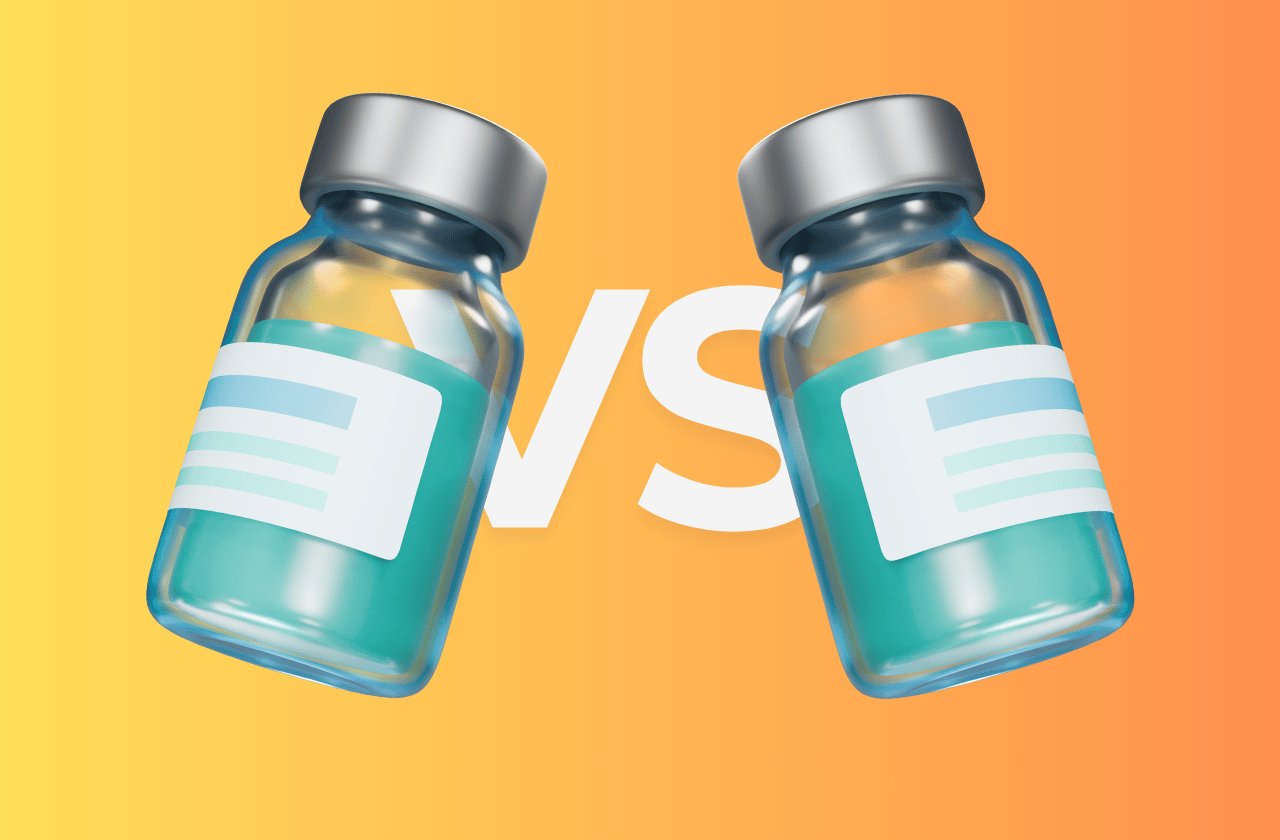[Disclaimer: This article is for informational purposes only and does not constitute medical advice. Always consult with a qualified healthcare provider before starting any peptide therapy.]
Tesamorelin and ipamorelin are two growth hormone-releasing peptides that reduce body fat through different mechanisms, with tesamorelin targeting visceral fat specifically and ipamorelin providing broader body composition benefits.
Both peptides boost your body’s natural growth hormone production. Tesamorelin works through GHRH receptors while ipamorelin targets ghrelin receptors.
Key Takeaways
- Tesamorelin targets belly fat specifically and reduces visceral fat by 20% in 26 weeks
- Ipamorelin offers gentler fat loss with fewer side effects and better long-term safety
- Both peptides boost natural growth hormone production but use different pathways
- Medical supervision is required for safe use of either peptide therapy
What Are Growth Hormone-Releasing Peptides?
Growth hormone-releasing peptides are synthetic compounds that stimulate your pituitary gland to produce more natural growth hormone. These peptides include tesamorelin, ipamorelin, sermorelin, and CJC-1295.
Unlike direct hormone replacement, these peptides work with your existing endocrine systems. They target specific receptors in your hypothalamus and pituitary gland.
How Peptide Therapies Work
Peptide therapies bind to specific receptors including GHRH receptors, ghrelin receptors, and growth hormone secretagogue receptors. This binding triggers the release of growth hormone from the anterior pituitary gland.
Growth hormone breaks down fat cells through lipolysis and promotes muscle protein synthesis. Adults over 30 experience a 14% decline in growth hormone production per decade[1].
Tesamorelin: The Visceral Fat Fighter
Tesamorelin is an FDA-approved synthetic growth hormone-releasing hormone analog that reduces visceral abdominal fat by 20% in 26 weeks. The FDA approved tesamorelin specifically for treating lipodystrophy in HIV patients[2].
This peptide functions as a synthetic analog of growth hormone-releasing hormone (GHRH). It binds directly to GHRH receptors in your anterior pituitary gland.
Benefits of Tesamorelin
Tesamorelin reduces visceral adipose tissue by 20%, liver fat by 4.9%, and triglycerides by 25% within 26 weeks of treatment[3]. Clinical studies demonstrate these results consistently across multiple patient populations including HIV patients and those with metabolic syndrome.
The peptide increases IGF-1 levels by an average of 117 ng/mL compared to placebo treatment[2].
Key Benefits:
- Targets dangerous visceral fat specifically
- Reduces triglyceride levels by 25%
- Improves insulin sensitivity
- Decreases abdominal circumference
“The current study suggests that achieving an 8% or greater reduction in visceral adiposity as a result of tesamorelin is associated with metabolic benefits.”
Stanley, Takara L et al., Clinical infectious diseases : an official publication of the Infectious Diseases Society of America
Mechanism of Action for Tesamorelin
Tesamorelin mimics your body’s natural GHRH hormone. It stimulates the anterior pituitary to release growth hormone in pulses.
This creates a natural pattern that doesn’t disrupt your body’s feedback loops. The result is increased IGF-1 levels and enhanced fat burning.
Ipamorelin: The Gentle Growth Hormone Booster
Ipamorelin is a selective ghrelin receptor agonist that stimulates growth hormone release without affecting cortisol, prolactin, or ACTH levels. This selectivity makes ipamorelin the safest growth hormone secretagogue for long-term use.
The peptide binds specifically to GHS-R1a receptors in the hypothalamus and pituitary gland[4]. Ipamorelin is generally well-tolerated with discontinuation rates similar to placebo in clinical trials.
How Ipamorelin Works
This peptide mimics ghrelin, often called the “hunger hormone.” But unlike ghrelin, ipamorelin doesn’t increase appetite significantly[5].
It binds to specific ghrelin receptors in your hypothalamus and pituitary gland. This triggers a controlled release of growth hormone without affecting other hormones like cortisol or prolactin.
Benefits for Body Composition
Ipamorelin provides steady, moderate improvements in body composition. Users often report gradual fat loss combined with muscle preservation.
The effects build over time rather than showing dramatic early changes. This makes it ideal for long-term body recomposition goals.
Primary Benefits:
- Gradual, sustainable fat loss
- Preserves lean muscle mass
- Improves sleep quality
- Supports recovery and healing
- Minimal impact on other hormones
Tesamorelin and Ipamorelin: Side-by-Side Comparison
Both peptides stimulate natural growth hormone production but through different pathways. This creates distinct profiles for effectiveness and safety.
| Factor | Tesamorelin | Ipamorelin |
|---|---|---|
| Primary Target | Visceral fat | Overall body composition |
| Mechanism | GHRH analog | Ghrelin receptor agonist |
| FDA Status | Approved for HIV lipodystrophy | Research/off-label use |
| Side Effects | More frequent | Minimal |
| Speed of Results | Faster (weeks) | Slower (months) |
Fat Loss Results: What to Expect
Tesamorelin shows faster, more dramatic results for abdominal fat reduction. Studies document significant improvements in just 26 weeks.
Ipamorelin provides steadier, more gradual changes. Users typically see improvements over 3-6 months of consistent use.
Tesamorelin Fat Loss Timeline
Tesamorelin produces measurable visceral fat reduction within 4-6 weeks, with peak effects occurring at 26 weeks of continuous treatment. Patients lose an average of 18% of visceral fat by week 26.
Stopping tesamorelin treatment results in gradual fat regain over 12-26 weeks. Approximately 60% of the fat loss benefit disappears within 6 months of discontinuation.
Ipamorelin Results
Ipamorelin produces noticeable body composition changes after 8-12 weeks of consistent treatment. Users experience gradual fat loss of 3-5% and lean muscle preservation or gain of 2-4% over 16 weeks.
The most significant improvements occur between weeks 12-20 of treatment. Body composition changes include reduced subcutaneous fat, improved muscle definition, and enhanced recovery.
Dosage and Administration
Both peptides require subcutaneous injection using 28-31 gauge insulin syringes, typically administered 2-3 hours before bedtime. Proper timing aligns with your body’s natural growth hormone peak that occurs 90-120 minutes after sleep onset.
Tesamorelin Dosage Protocol
Tesamorelin dosing follows a standard protocol of 2mg (2000mcg) daily, injected subcutaneously into the abdomen. Treatment requires continuous daily administration for 26 weeks to achieve maximum visceral fat reduction.
Healthcare providers monitor IGF-1 levels every 26 weeks during treatment. Levels exceeding 2 standard deviations above normal require dose reduction or discontinuation.
Ipamorelin Dosing Guidelines
Ipamorelin doses range from 200-300mcg per injection, administered 1-3 times daily depending on individual goals. Most protocols use 200mcg twice daily (morning and evening) or 300mcg once daily before bed.
Treatment cycles typically last 12-16 weeks followed by 4-week breaks to prevent receptor desensitization. Some practitioners prescribe continuous low-dose protocols of 100-150mcg daily for anti-aging purposes.
Important Injection Tips:
- Rotate injection sites to prevent irritation
- Use proper sterile technique
- Store peptides refrigerated
- Allow to reach room temperature before injecting
💡PEPTIDE PICKS: MORE TO EXPLORE
- Want to explore beyond tesamorelin and ipamorelin? There are several other peptides that excel at fat loss. Check out our complete guide to the best peptides for weight loss.
- Female metabolism works differently than men’s. That’s why we created a specialized guide covering the 7 best peptides for female fat loss.
- Ready to take things up a notch? Learn how to combine peptides for maximum results with our CJC-1295 and ipamorelin dosage guide.
Safety and Side Effects
Both peptides carry different risk profiles. Understanding these differences helps guide your choice.
Tesamorelin Safety Concerns
Tesamorelin produces injection site reactions in 17% of users compared to 6% with placebo injections. Joint pain affects 15% of patients while muscle pain occurs in 12% during the first 8 weeks of treatment.
Approximately 50% of patients develop antibodies to tesamorelin after 26 weeks of treatment. These antibodies may reduce the peptide’s effectiveness over time.
Serious Considerations:
- May worsen glucose tolerance
- Contraindicated in pregnancy (Category X)
- Requires monitoring for diabetes development
- Not recommended with active cancer
Ipamorelin Safety Profile
Ipamorelin shows excellent safety in clinical studies. Discontinuation rates remain similar to placebo in most trials[6].
Side effects are typically mild and temporary. The most common issues are slight injection site irritation and occasional headaches.
Minimal Risk Factors:
- No impact on cortisol or prolactin
- Doesn’t suppress natural GH production
- Well-tolerated long-term
- Lower overall risk profile
Who Should Choose Which Peptide?
Your choice depends on your specific goals, health status, and risk tolerance. Both options can be effective when used appropriately.
Choose Tesamorelin If You Have:
- Significant visceral fat accumulation that needs targeted treatment. This peptide excels at reducing dangerous belly fat.
- HIV-related lipodystrophy or metabolic syndrome. These conditions have the strongest research support.
- Access to regular medical monitoring. Tesamorelin requires more frequent check-ups and lab work.
Choose Ipamorelin If You Want:
- A gentler approach to body recomposition. This option works well for general anti-aging and wellness goals.
- Lower risk of side effects. Ipamorelin’s safety profile makes it suitable for more people.
- Long-term use without significant monitoring. This peptide requires less frequent lab work.
Medical Supervision Required
Both peptides should only be used under medical supervision. Your healthcare provider can assess your individual risk factors and monitor your progress.
Quality matters tremendously with peptides. Only obtain these medications from licensed physicians and accredited compounding pharmacies.
Combining Peptides: Tesamorelin, Ipamorelin, and Sermorelin
Some practitioners prescribe multiple peptides together for enhanced results. Popular combinations include ipamorelin and tesamorelin with sermorelin.
Sermorelin works similarly to tesamorelin as a GHRH analog but with a shorter duration. It may provide gentler stimulation when combined with other growth hormone secretagogues.
The theory is that different pathways could work together. However, combination approaches require careful monitoring and aren’t widely studied.
Always discuss combination therapy with your doctor. They can determine if this approach makes sense for your situation.
The Bottom Line
Ipamorelin provides the safer option for 80% of people seeking fat loss benefits due to its selective receptor targeting and 4% discontinuation rate. Its mechanism preserves natural hormone feedback loops without affecting cortisol or prolactin levels.
Tesamorelin remains the superior choice for targeted visceral fat reduction, producing 20% decreases in abdominal fat within 26 weeks. The FDA approval for HIV lipodystrophy validates its effectiveness for dangerous belly fat accumulation.
Both peptides require combination with proper nutrition and exercise for optimal results. They enhance fat loss by 15-25% compared to diet and exercise alone.
Making Your Decision
Consult with a qualified healthcare provider who specializes in peptide therapies. They can evaluate your health status, goals, and risk factors.
Consider starting with the safer option (ipamorelin) unless you have specific indications for tesamorelin. You can always adjust your approach based on results.
Remember that sustainable fat loss takes time regardless of which peptide you choose. Be patient and consistent for the best outcomes.
References
- A. Bartke, “Growth hormone and aging,” Springer Science and Business Media LLC, Oct. 2020. doi: 10.1007/s11154-020-09593-2. https://doi.org/10.1007/s11154-020-09593-2
- T. L. Stanley et al., “Reduction in Visceral Adiposity Is Associated With an Improved Metabolic Profile in HIV-Infected Patients Receiving Tesamorelin,” Oxford University Press (OUP), Apr. 2012. doi: 10.1093/cid/cis251. https://doi.org/10.1093/cid/cis251
- T. McLaughlin, S. K. Grinspoon, T. Stanley, and L. Fourman, “1499. Tesamorelin Reduces Visceral Adipose Tissue and Liver Fat in INSTI-Treated Persons with HIV,” Oxford University Press (OUP), Nov. 2023. doi: 10.1093/ofid/ofad500.1334. https://doi.org/10.1093/ofid/ofad500.1334
- M. Gouda and C. B. Ganesh, “The influence of ghrelin agonist ipamorelin acetate on the hypothalamic-pituitary-testicular axis in a cichlid fish, Oreochromis mossambicus,” Elsevier BV, Sep. 2024. doi: 10.1016/j.anireprosci.2024.107550. https://doi.org/10.1016/j.anireprosci.2024.107550
- D. K. Sinha et al., “Beyond the androgen receptor: the role of growth hormone secretagogues in the modern management of body composition in hypogonadal males,” AME Publishing Company, Mar. 2020. doi: 10.21037/tau.2019.11.30. https://doi.org/10.21037/tau.2019.11.30
- D. E. Beck, W. B. Sweeney, and M. D. McCarter, “Prospective, randomized, controlled, proof-of-concept study of the Ghrelin mimetic ipamorelin for the management of postoperative ileus in bowel resection patients,” Springer Science and Business Media LLC, Oct. 2014. doi: 10.1007/s00384-014-2030-8. https://doi.org/10.1007/s00384-014-2030-8









